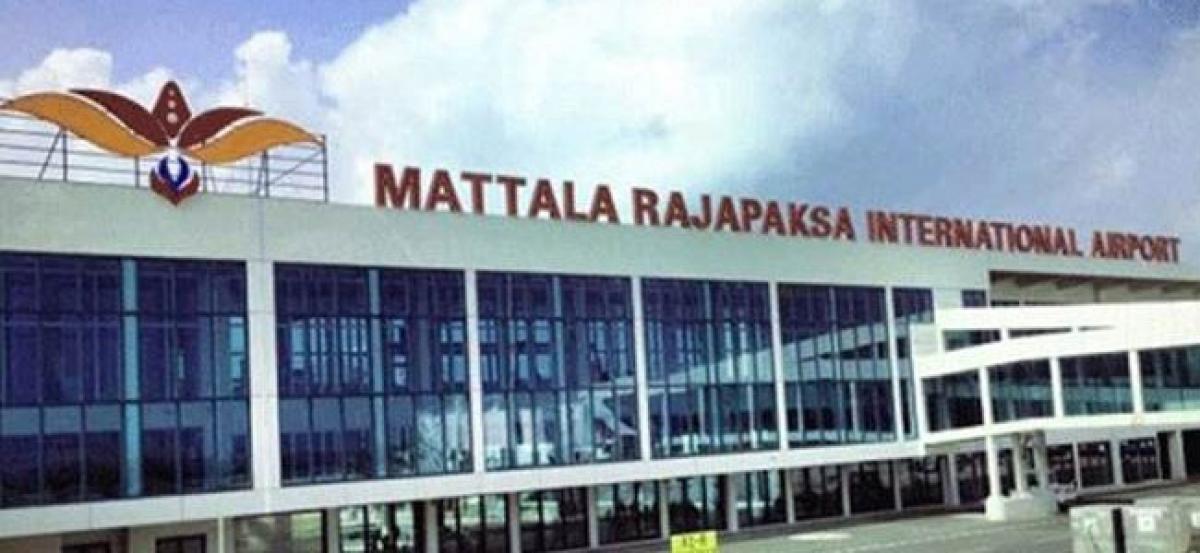Live
- Pakistan Protests: PTI Supporters March Towards Islamabad, Demanding Imran Khan's Release
- Additional Collector Conducts Surprise Visit to Boys' Hostel in Wanaparthy
- Punjab hikes maximum state-agreed price for sugarcane, highest in country
- Centre okays PAN 2.0 project worth Rs 1,435 crore to transform taxpayer registration
- Punjab minister opens development projects of Rs 120 crore in Ludhiana
- Cabinet approves Atal Innovation Mission 2.0 with Rs 2,750 crore outlay
- Centre okays Rs 3,689cr investment for 2 hydro electric projects in Arunachal
- IPL 2025 Auction: 13-year-old Vaibhav Suryavanshi becomes youngest player to be signed in tournament's history
- About 62 lakh foreign tourists arrived in India in 8 months this year: Govt
- IPL 2025 Auction: Gujarat bag Sherfane Rutherford for Rs 2.60 cr; Kolkata grab Manish Pandey for Rs 75 lakh
Just In
“India to play a sensitive friend or a bully big brother?” regarding the Sri Lankan airport


In an interview last year, Sri Lankas PM Ranil Wickremesinghe extended some invitations to India One of them has just reached fruition For at least 40 years and through a majority stake in a joint venture, India will soon run Mattala, the Sri Lankan airport in the southeastern coastal district of Hambantota
In an interview last year, Sri Lanka’s PM Ranil Wickremesinghe extended some invitations to India. One of them has just reached fruition. For at least 40 years and through a majority stake in a joint venture, India will soon run Mattala, the Sri Lankan airport in the southeastern coastal district of Hambantota. Also known as the Mattala (Mahinda) Rajapaksa International Airport, after the country’s former President and current strongman of Sri Lanka Joint Opposition, the terminals threw open their doors in 2013.
Hambantota, 240 km southeast of the Sri Lankan capital, is also home to a controversial, China-built seaport, which, like Mattala airport, has been visited by more journalists than ships so far. Farmers and Buddhist monks were protesting against the decision by Mr Wickremesinghe government to hand over the port and an additional 15,000 acres of mostly farmland back to China for 99 years. At the time of the controversial debt-for-equity swap, Sri Lanka owed China $8 billion, one-twelfth of its staggering overall overseas debt.
If it earlier bristled over Chinese submarines “dropping in” on Colombo without prior warning to India, China’s debt-trap stranglehold over Sri Lanka in Hambantota multiplied New Delhi’s concerns tenfold. Yet, Mr Wickremesinghe brushed off India’s worries. “We have always been friendly with China, but not at the expense of India, If there is still some uneasiness, it is (because of) the Indian media, that reports from their point of view. There is nothing I can do about it.” he said.
The airport was built to handle one million passengers, 50,000 tonnes of cargo and 6,250 air traffic operations every year. Earlier this year, it lost its last customer and its hangars are reportedly being used by local farmers to store rice.
Hambantota seaport is firmly in China’s hands. Rumours that Beijing intends it for military use are so persistent that the Sri Lankan Navy is relocating its southern naval command to the region. Mattala airport is just 35 km away. Establishing a presence there will give India the opportunity to literally breathe down China’s neck and monitor its every movement.
There is already close cooperation between the Indian and Sri Lankan navies. The host country, along with Japan and Australia, recently participated in a “humanitarian” naval mission under US command in the seas off Hambantota.
In the era of terrorism, arrivals and departures by air are the least pleasurable aspects of a holiday. Even when it's long-overdue expansion is completed, Colombo airport will remain a fraction of the size of Delhi’s Terminal 3, which, despite its gargantuan proportions, is already overwhelmed by traffic. It’s only a matter of time before tourists in Sri Lanka will yearn for alternatives.
Consequentially, almost everything points to the fact that if Mattala airport is well marketed and incentivised by Sri Lanka’s tourism authorities, it may well be a commercial success. And even if it isn’t, India’s reported investment of $300 million into the airport will reap other strategic rewards.
India has much to gain from its joint venture in Mattala and other places, but New Delhi would be wise to read the signals. India-bashing is the favourite pastime of all neighbouring countries anyway. And despite the cultural cousinhood between India and Sri Lanka, Sri Lankans are anything but serendipitous about the big neighbour.
Sri Lanka’s majority Buddhists are more concerned about growing Hindu chauvinism over the “Ramayana link” in Sri Lanka. They fear that Indian investment to especially in Sinhalese-dominated districts may be a smokescreen for cultural subjugation.
As with all big-ticket projects and especially along one of the most spectacular coastlines in the world, real estate vultures will invariably hover, high rise condominiums at spots like the monastery guarantee a killing.
“Yes, Buddhism is a peaceful religion,” chief monk and fierce protester Thera Gotabhaya Amitha told a source. “But Buddhism’s connection with our people is like a tree and its skin. We will do more than what it takes to resist this port. And if we die? We don’t care.”
But if India plays the sensitive friend and not the bully big brother, its arrival in Sinhalese-dominated southern Sri Lanka could be the beginning of a beautiful friendship.

© 2024 Hyderabad Media House Limited/The Hans India. All rights reserved. Powered by hocalwire.com






